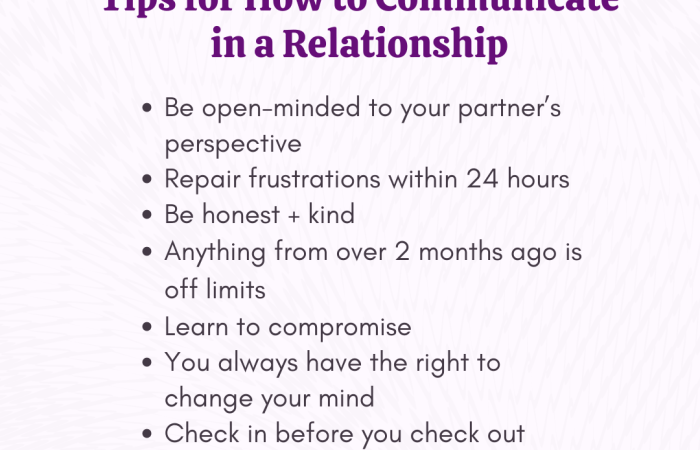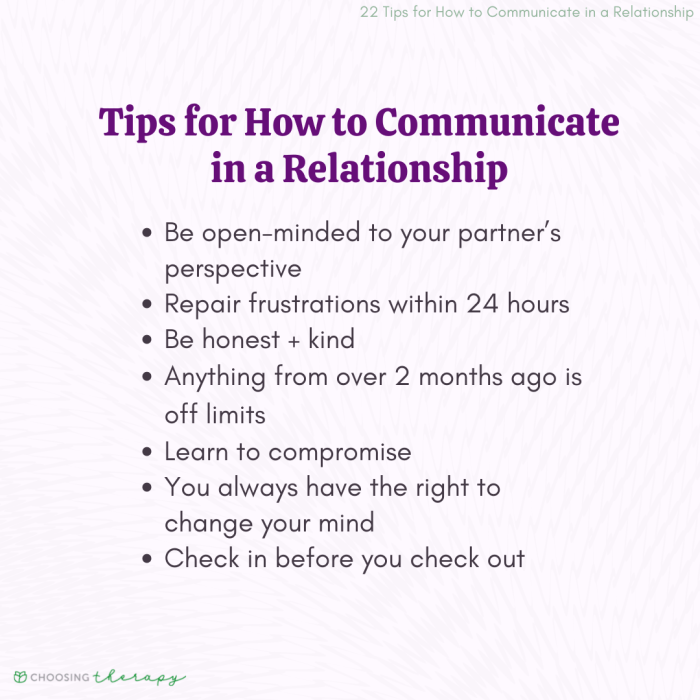Communication Help for Couples: Strengthen Your Bond

Communication Help for Couples sets the stage for a deeper understanding of the dynamics that shape romantic relationships. Effective communication is the cornerstone of a strong and fulfilling partnership, yet many couples find themselves navigating the complexities of expressing their needs, resolving conflicts, and maintaining a healthy connection.
This guide delves into the essential elements of successful communication in relationships, offering practical insights and actionable strategies. From understanding common communication roadblocks to mastering active listening and conflict resolution, we’ll explore a comprehensive approach to fostering open and honest dialogue within your partnership.
Understanding Communication Challenges

Effective communication is the cornerstone of any healthy relationship. When couples struggle to communicate effectively, it can lead to misunderstandings, resentment, and conflict.
Common Communication Roadblocks
Communication roadblocks can hinder open and honest dialogue. Here are some common roadblocks:
- Defensive listening: This involves focusing on how to respond rather than truly understanding the other person’s perspective. It often involves interrupting, dismissing, or arguing back.
- Mind-reading: Assuming you know what your partner is thinking or feeling without asking for clarification. This can lead to misinterpretations and hurt feelings.
- Stonewalling: Withdrawing from a conversation or refusing to engage. This can be a form of passive-aggressive behavior and creates distance in the relationship.
- Criticism: Focusing on personal flaws or negative attributes rather than offering constructive feedback. This can be hurtful and damaging to self-esteem.
- Contempt: Expressing disrespect or disdain for your partner through insults, mockery, or sarcasm. This is highly corrosive to relationships.
Differing Communication Styles
Communication styles can vary significantly between individuals. These differences can lead to conflict if not acknowledged and addressed.
- Direct vs. Indirect Communication: Some individuals prefer direct, assertive communication, while others prefer indirect, subtle cues. This can lead to misunderstandings if one partner expects the other to communicate in a style they are not comfortable with.
- Verbal vs. Nonverbal Communication: Some people are more comfortable expressing themselves verbally, while others rely heavily on nonverbal cues like body language and tone of voice. Misinterpretations can occur if these differences are not recognized.
- Emotional vs. Logical Communication: Some people tend to communicate emotionally, while others focus on logic and reason. This can create conflict if one partner feels unheard or invalidated by the other’s communication style.
Impact of Unresolved Conflicts
Unresolved conflicts can have a significant impact on relationships.
- Increased Stress and Anxiety: Constant conflict creates a stressful environment that can negatively affect mental and physical health.
- Erosion of Trust: When conflicts are not addressed, it can erode trust between partners. This can lead to feelings of insecurity and doubt.
- Distance and Isolation: Unresolved conflicts can create distance and isolation in a relationship. Partners may withdraw emotionally or physically, leading to a sense of loneliness and disconnection.
- Negative Communication Patterns: Unresolved conflicts can lead to the development of negative communication patterns, such as blaming, arguing, or stonewalling. These patterns can become ingrained and difficult to break.
Active Listening and Empathetic Communication

Active listening and empathetic communication are essential skills for any relationship, but especially for couples. They foster understanding, connection, and a sense of being heard. By actively listening and empathizing with your partner, you can build a stronger bond and navigate challenges together.
Active Listening Techniques
Active listening involves paying full attention to your partner, both verbally and nonverbally. It’s about more than just hearing their words; it’s about understanding their perspective and feelings. Here are some techniques to practice active listening:
- Make eye contact: Eye contact demonstrates that you are engaged and present in the conversation. It also helps you to read your partner’s nonverbal cues, such as facial expressions and body language.
- Put away distractions: Turn off your phone, close your laptop, and focus solely on your partner. Avoid multitasking or letting your mind wander.
- Listen for both verbal and nonverbal cues: Pay attention to your partner’s tone of voice, body language, and facial expressions. These cues can provide valuable insights into their feelings and emotions.
- Summarize and clarify: To ensure understanding, paraphrase what your partner has said in your own words. This allows them to correct any misunderstandings and helps you to demonstrate that you are actively listening.
- Ask open-ended questions: Instead of asking yes/no questions, ask open-ended questions that encourage your partner to elaborate on their thoughts and feelings. For example, instead of asking “Are you upset?”, try asking “What’s going on? How are you feeling right now?”
- Avoid interrupting: Allow your partner to finish their thoughts without interrupting. It’s tempting to jump in with your perspective, but it’s important to let them fully express themselves first.
- Use verbal and nonverbal cues to show you’re listening: Nod your head, make appropriate facial expressions, and use phrases like “I understand,” “That makes sense,” or “Tell me more.” These cues signal to your partner that you are engaged and attentive.
Validating Your Partner’s Feelings
Validating your partner’s feelings means acknowledging and accepting their emotions, even if you don’t agree with them. It’s about showing empathy and understanding, without judgment.
- Avoid dismissing their feelings: Phrases like “Don’t be so sensitive” or “You’re overreacting” can invalidate your partner’s emotions and make them feel unheard. Instead, acknowledge their feelings and try to understand why they are experiencing them.
- Use “I” statements: Instead of saying “You’re making me feel…” try “I feel…” This takes ownership of your own emotions and avoids blaming your partner. For example, instead of saying “You’re making me angry,” try “I feel angry when you…”
- Focus on understanding their perspective: Try to see things from your partner’s point of view, even if you don’t agree with them. Ask questions to understand their perspective and why they feel the way they do.
- Emphasize shared experiences: When possible, connect with your partner’s feelings by sharing similar experiences. This can help them feel understood and validated.
Communicating Your Own Needs and Desires
Expressing your own needs and desires is just as important as listening to your partner. Open and honest communication is key to a healthy relationship.
- Use “I” statements: This helps you to take ownership of your feelings and avoid blaming your partner. For example, instead of saying “You never listen to me,” try “I feel unheard when I share my thoughts with you.”
- Be specific: Instead of making broad generalizations, be specific about what you need or want. For example, instead of saying “I need more attention,” try “I would appreciate it if you could spend more quality time with me.”
- Choose the right time and place: Avoid bringing up sensitive topics when you are both stressed or tired. Choose a time when you can both focus on the conversation.
- Be respectful: Even when you are expressing your needs, be respectful of your partner’s feelings and opinions. Avoid being accusatory or critical.
Conflict Resolution Strategies

Disagreements are a natural part of any relationship. However, the way you handle these conflicts can significantly impact the health and happiness of your relationship. Effective conflict resolution strategies can help you navigate disagreements constructively and strengthen your bond.
A Step-by-Step Process for Resolving Disagreements
A structured approach can help couples effectively address conflicts. Here’s a step-by-step process:
- Identify the Issue: Clearly define the specific issue at hand. Avoid bringing up past grievances or unrelated topics. For example, instead of saying “You never listen to me,” try “I feel unheard when you interrupt me while I’m talking about my day.”
- Active Listening: Pay attention to your partner’s perspective. Listen without interrupting, trying to understand their feelings and needs. Use phrases like “I understand you feel…” or “It sounds like you’re saying…” to show you’re listening.
- Empathetic Communication: Validate your partner’s feelings, even if you don’t agree with their perspective. Let them know you understand their point of view. For instance, you could say, “I can see why you’re upset about this.”
- Find Common Ground: Look for areas where you agree or have shared goals. Focus on finding solutions that benefit both of you.
- Brainstorm Solutions: Generate multiple solutions together. This collaborative approach can help you find a mutually acceptable outcome.
- Choose a Solution: Discuss the proposed solutions and choose one that addresses both your needs and concerns. Be willing to compromise.
- Implement and Evaluate: Put the chosen solution into practice and assess its effectiveness. Be open to making adjustments if necessary.
Techniques for Managing Anger and Frustration
Anger and frustration are common emotions during conflicts. Learning to manage these emotions is crucial for healthy communication:
- Take a Break: If you feel your emotions escalating, take a break from the conversation. Step away for a few minutes to calm down. This allows you to regain composure and approach the issue with a clearer mind.
- Use “I” Statements: Express your feelings and needs using “I” statements. For example, instead of saying “You’re always late,” say “I feel frustrated when you’re late because it makes me feel disrespected.” This avoids blaming your partner and focuses on your own experience.
- Focus on the Present: Avoid bringing up past grievances or dwelling on past conflicts. Stick to the current issue at hand.
- Practice Mindfulness: Mindfulness techniques, such as deep breathing or meditation, can help you stay calm and grounded during disagreements.
Comparing and Contrasting Conflict Resolution Styles
Couples often have different approaches to resolving conflicts. Understanding these styles can help you navigate disagreements more effectively:
- Collaborators: These individuals prioritize finding solutions that benefit both parties. They engage in open communication, actively listen, and seek compromise.
- Competitors: Competitors focus on winning the argument and achieving their own goals, even if it means sacrificing their partner’s needs. They may be assertive and demanding.
- Avoiders: Avoiders tend to avoid conflict altogether. They may withdraw from the conversation, change the subject, or downplay the issue.
- Accommodators: Accommodators prioritize their partner’s needs over their own. They may agree with their partner to avoid conflict, even if it means sacrificing their feelings.
Building a Strong Communication Foundation: Communication Help For Couples

Communication is the lifeblood of any relationship, and for couples, it’s the foundation upon which love, trust, and intimacy are built. Consistent and open communication is essential for navigating the ups and downs of a relationship, resolving conflicts, and fostering a deeper understanding of each other.
Regular Communication
Regular communication is vital for maintaining a strong and healthy relationship. It allows couples to stay connected, share their thoughts and feelings, and build a shared understanding of each other’s perspectives.
- Schedule dedicated time for conversation: Even if it’s just for 15 minutes a day, set aside time to talk without distractions, allowing each person to express themselves fully.
- Engage in regular check-ins: These can be brief conversations to touch base on how each person is feeling, what’s going on in their lives, and how they’re coping with any challenges.
- Make communication a habit: Don’t wait for a problem to arise to talk. Regular communication helps to prevent misunderstandings and maintain a strong connection.
Creating a Safe and Open Space for Dialogue
A safe and open space for communication is essential for couples to feel comfortable expressing themselves without fear of judgment or retaliation.
- Establish ground rules: Agree on some basic rules for communication, such as listening attentively, respecting each other’s opinions, and avoiding interrupting.
- Create a non-judgmental environment: Focus on understanding each other’s perspectives, even if you don’t agree with them. Avoid labeling or criticizing each other’s feelings.
- Choose a comfortable setting: Find a quiet and private space where you can talk without distractions. This can be at home, in a park, or even on a walk.
Essential Communication Skills for Couples
Strong communication skills are essential for building a strong relationship. These skills help couples to understand each other better, resolve conflicts effectively, and create a more fulfilling and loving connection.
- Active Listening: This involves paying full attention to your partner, both verbally and nonverbally. It means focusing on what they are saying, asking clarifying questions, and reflecting on what you understand.
- Empathetic Communication: This involves trying to understand your partner’s perspective and feelings, even if you don’t agree with them. It requires putting yourself in their shoes and acknowledging their emotions.
- Assertive Communication: This involves expressing your own needs and feelings clearly and directly while respecting your partner’s boundaries. It’s about finding a balance between being assertive and being respectful.
- Conflict Resolution Skills: These are essential for navigating disagreements healthily and constructively. They involve strategies for identifying the root cause of the conflict, finding common ground, and reaching a mutually acceptable solution.
Seeking Professional Help
Seeking professional help for relationship challenges can be a positive step towards strengthening your bond. Couples therapy or counseling provides a safe and structured environment to address communication issues, improve understanding, and develop healthy conflict resolution skills.
Benefits of Couples Therapy
Couples therapy offers numerous benefits that can enhance communication and improve the overall quality of your relationship. It provides a neutral space for couples to explore their feelings, understand each other’s perspectives, and develop strategies for resolving conflicts.
- Improved Communication: Couples therapy helps couples learn effective communication techniques, such as active listening, expressing needs and feelings clearly, and understanding each other’s perspectives.
- Enhanced Conflict Resolution: Therapists guide couples in developing healthy conflict resolution strategies, enabling them to navigate disagreements constructively and reach mutually acceptable solutions.
- Increased Intimacy and Connection: By fostering deeper understanding and empathy, couples therapy can strengthen emotional bonds and improve intimacy levels.
- Reduced Stress and Anxiety: Relationship conflicts can cause significant stress and anxiety. Couples therapy provides a supportive environment to address these issues and develop coping mechanisms.
- Improved Relationship Satisfaction: Studies have shown that couples therapy can significantly improve relationship satisfaction and reduce the risk of separation or divorce.
Situations Where Seeking Professional Help is Recommended
Seeking professional help is recommended when couples face challenges that they are unable to resolve on their own. Here are some common situations:
- Recurring Conflicts: If you and your partner find yourselves constantly arguing about the same issues, it may be beneficial to seek professional guidance.
- Communication Breakdown: When communication becomes strained or ineffective, making it difficult to understand each other’s needs and feelings, couples therapy can provide valuable tools.
- Lack of Intimacy: If you are experiencing a decline in intimacy or emotional connection, seeking professional support can help you address underlying issues and rebuild closeness.
- Significant Life Changes: Major life events, such as the birth of a child, career changes, or illness, can put stress on a relationship. Couples therapy can provide support during these transitions.
- Infidelity or Betrayal: When infidelity or betrayal occurs, couples therapy can be crucial in rebuilding trust and repairing the relationship.
Finding Qualified Relationship Therapists, Communication help for couples
Finding a qualified relationship therapist is essential for a successful therapeutic experience. Here are some resources for locating qualified professionals:
- American Association for Marriage and Family Therapy (AAMFT): The AAMFT provides a directory of licensed marriage and family therapists (LMFTs) who have met specific training and ethical standards. You can search for therapists in your area by specialization, such as couples counseling.
- American Psychological Association (APA): The APA maintains a directory of psychologists who specialize in couples therapy. You can search for therapists based on location, specialty, and other criteria.
- Your Insurance Provider: Contact your insurance provider to obtain a list of therapists in your network who specialize in couples therapy.
- Professional Organizations: Many local and national professional organizations for therapists offer directories of members who provide couples counseling services.
Conclusive Thoughts
By implementing these communication strategies, couples can transform their relationships into spaces of mutual understanding, respect, and growth. Open communication is a continuous journey, requiring dedication and effort from both partners. Remember, the goal is not to achieve perfect communication, but to cultivate a safe and supportive environment where you can both feel heard, understood, and valued.
Comments are closed.